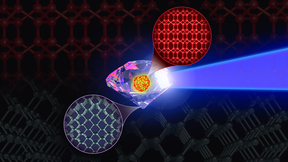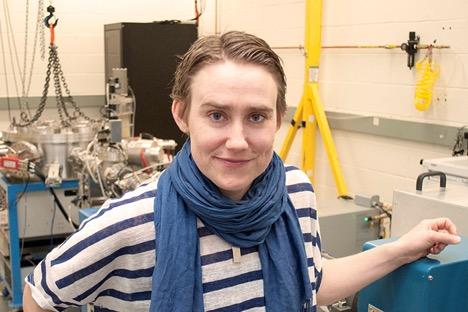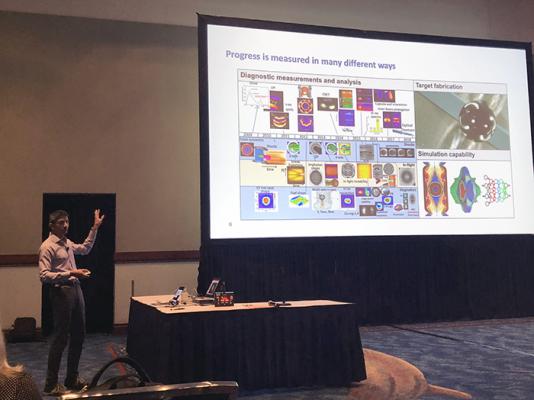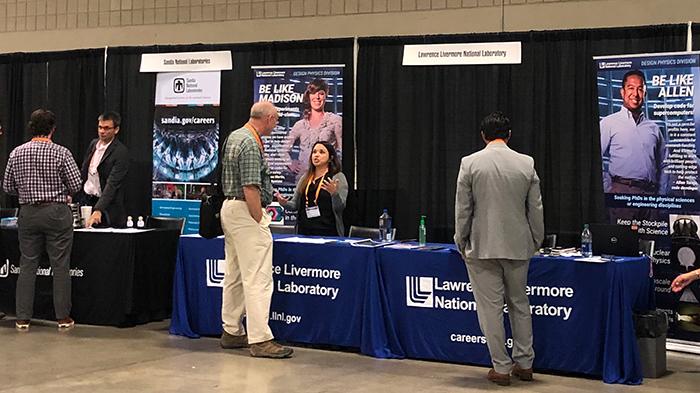NIF experiments draw interest at APS conference
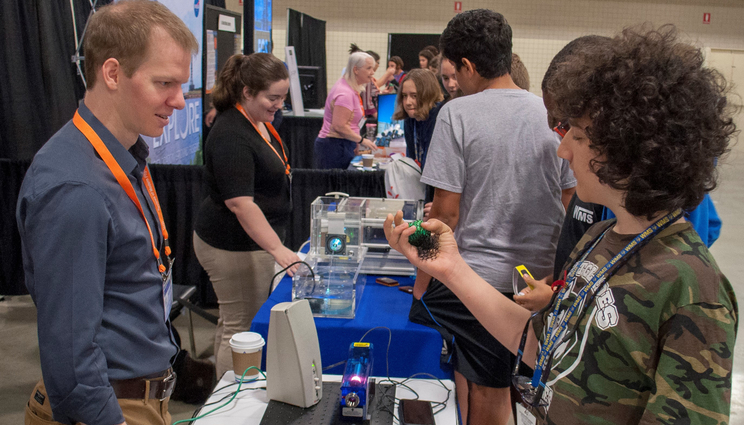 (Download Image)
(Download Image)
LLNL research physicist Patrick Poole and postdoctoral researcher Ginerva Cochran took the NIF Laser Roadshow to the APS conference’s annual Student Plasma Science Expo, attended by students from the Fort Lauderdale area.
Ongoing experiments on the sun’s nucleosynthesis (element creation) processes and an update on progress toward achieving ignition were among the dozen invited talks about NIF-related research at the American Physical Society plasma physics conference this fall.
The talks, which highlight the importance of NIF & Photon Science Directorate research, drew widespread interest from attendees of the 61st annual APS Division of Plasma Physics meeting in Fort Lauderdale, Florida.
MIT nuclear physicist Maria Gatu Johnson, who plays a key role in NIF’s inertial confinement fusion (ICF) and Discovery Science campaigns, delivered the Katherine E. Weimer Award talk on “Studying 3D Asymmetries and Resulting Flows in ICF Implosions, and Using ICF Implosions to Study Nuclear Reactions Relevant to Stellar Nucleosynthesis.”
Maria Gatu Johnson. Photo by Paul Rivenberg/MITEarlier this year, Gatu Johnson, the lead project scientist for the experiments, was named winner of the biennial Weimer Award, which recognizes outstanding plasma science research by a woman physicist in the early stages of her career (see “Physicist Maria Gatu Johnson Wins APS Award”).
The experiments use NIF’s 192 high-power lasers to study the 3He+3He reaction between two helium ions in stellar-like conditions. The reaction accounts for nearly half of the energy generated by the sun as it burns hydrogen into helium.
“What is so cool about these experiments is that unlike in earlier studies on Earth, we are actually probing this reaction at temperature and density conditions comparable to those found in stars,” Gatu Johnson said in an APS news release highlighting her presentation.
Gatu Johnson reported on how protons from the solar 3He+3He reaction have been observed. “Surprisingly, the preliminary results show that at lower temperatures, relatively more protons are seen with higher energy than with lower energy,” she said.
The results will help scientists with their calculations of the 3He+3He reaction. The experiments are part of studies of nucleosynthesis reactions in stellar-like conditions using lasers such as NIF, the world’s largest and highest-energy laser.
“High-energy-density plasmas are the only way on Earth to recreate the extreme conditions in which the elements were produced in the universe,” said LLNL physicist Alex Zylstra, who is co-principal investigator.
In a one-hour tutorial geared toward graduate students and general audience members, LLNL physicist Pravesh Patel described NIF’s progress toward achieving ignition.
Pravesh Patel delivers his talk at the APS conference. Photo by Tammy Ma/LLNLThe talk “focused on the plasma conditions we have reached during stagnation in ICF implosions, in terms of pressure, temperature and on how we can use simple analytic models to understand power balance in the hot spot and our proximity to ignition,” Patel said. “A lot of people from outside our direct ICF community found it very educational.”
Lab ICF physicist Christopher Weber presented a talk titled, “Understanding the Impact of Ablator Micro-Structure and Fuel-Ablator Mixing on ICF Implosions.” Weber discussed the internal microstructures in the high-density carbon (diamond) ablators used in NIF implosions.
“They’re composed of many small diamond grains about a micron in size,” Weber said. “My simulations found that this can contribute to mixing between the deuterium-tritium (DT) fuel and the ablator. We are exploring this as a possible source for the lower-than-expected compression that has been observed in many of our implosion experiments.” (Compression is measured by comparing the number of high-energy neutrons generated in an implosion with the number of lower-energy, or scattered, neutrons, a factor known as the down-scattered ratio, or DSR.)
The topic generated much interest and “stimulated discussion about how else we can measure this effect and how other ablator materials (such as plastic and beryllium) differ,” he said.
And physicist Riccardo Tommasini presented a talk on “High Resolution Imaging of Inertially Confined Fusion Implosions Using Compton Radiography.”
“The cold fuel in ICF implosions can’t be seen by standard, photo-absorption X-ray imaging,” he said. “Therefore, we have developed a technique using Compton scattering of X-rays to produce radiographs sensitive to the cold-dense fuel around the hot spot. Our backlighting sources produce bursts of X-rays with energies exceeding 50keV (50,000 electron volts) and are generated by irradiating gold microwires as small as 10 microns in diameter with 30-picosecond-long ARC pulses. The microwires are aligned along the line of sight so that the spatial resolution is close to the wire diameter.
“In two experiments on the NIF, we have recorded radiographs of a tritium-hydrogen-deuterium layered indirect-drive implosion around peak compression. We reconstructed the cold fuel density, measured the asymmetries in the fuel and their evolution in time. We performed the first measurements of residual kinetic energy at stagnation. This ability to image the imploding fuel through peak compression is transforming what we know about ICF implosions,” he said.
LLNL’s recruiting booth at APS-DPP conference. Photo by Tammy Ma/LLNLThe other NIF-related invited talks were:
- Michael Campanell, LLNL: “Reduction of the Plasma Electron Temperature to the Emitted Electron Temperature Near Thermionic Surfaces With Inverse Sheaths.”
- Laurent Divol, LLNL: “3D Isobaric Hotspot ReconstructionFrom Multiple Neutron and X-ray Views on the NIF.”
- Andreas Kemp, LLNL: “Direct Electron Acceleration in Multi-Kilojoule, Multi-Picosecond Laser Pulses.”
- Edward Marley, LLNL: “Using X-ray Spectroscopy to Quantify Mix and Plasma Conditions in Ignition Experiments Using W-doped HDC Capsules at the NIF.”
- Ryan Nora, LLNL: “Modeling the 3D Structure of Ignition Experiments at the NIF.”
- George Swadling, LLNL: “First Direct Experimental Observation of Weibel-Mediated Collisionless Shock Formation and the Resulting Nonthermal Electron Acceleration in Laboratory Experiments.”
- Kevin Meany, Los Alamos National Laboratory: “Gamma Measured Ablator Areal Density Observations, Trends, and Time Shifts on the National Ignition Facility.”
- Sasi Palaniyappan, Los Alamos National Laboratory: “Hydro Scaling of Direct-Drive Cylindrical Implosions at the OMEGA and the National Ignition Facility.”
— Benny Evangelista
Contact
 Breanna Bishop
Breanna Bishop
[email protected]
(925) 423-9802
Related Links
Maria Gatu Johnson"Physicist Maria Gatu Johnson Wins APS Award"
APS news release
Pravesh Patel
Christopher Weber
Riccardo Tommasini
Tags
Lasers and Optical S&TLasers
National Ignition Facility and Photon Science
Featured Articles


